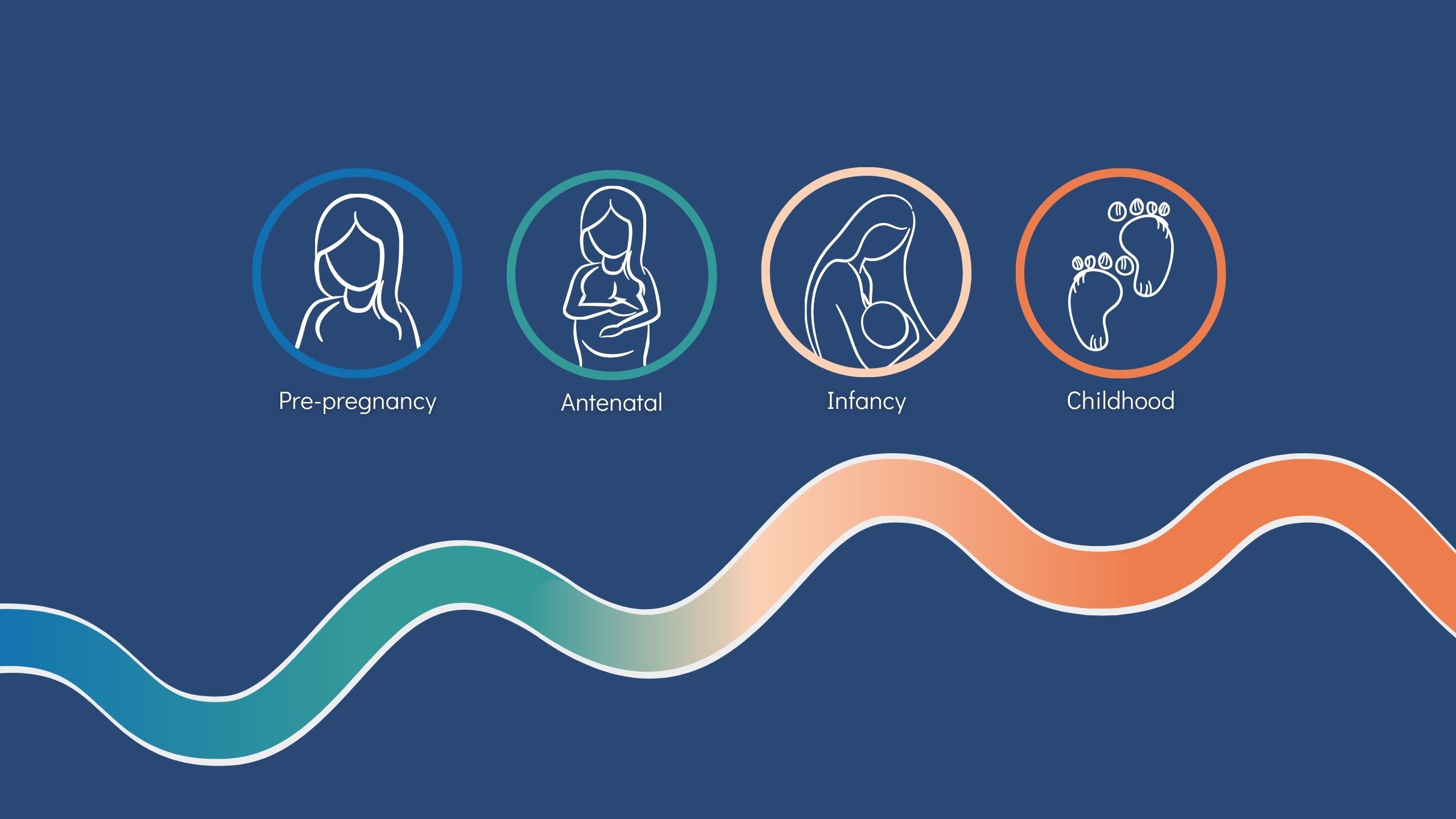MatCH
Newsletter
5th Anniversary Edition

We first invited you to participate in the Mothers and their Children's Health (MatCH) substudy back in 2016. Five years on, information about your parenting experiences and your children's health, development, and environment, has contributed to:
- 22 research papers published in national and international journals
- Newspapers, radio, and TV coverage of topics including children's screen time, perinatal mental health, play equipment, babies' first food, breastfeeding, and premature birth
- A submission to the Senate Inquiry into the Obesity Epidemic in Australia
What next for MatCH?
The MatCH substudy was funded through a Project Grant from the National Health and Medical Research Council (NHMRC) of Australia. For the past five years, our MatCH project researchers had exclusive access to the information you provided. We’re excited to announce that in late 2021, MatCH data will be added to ALSWH so it’s available to the broader community of researchers. Data sharing encourages collaboration between researchers which can lead to important new findings, making the best use of the data which you have so generously contributed. As always, your privacy remains our priority. Researchers will never be given identifying information about you or your family. Researchers wishing to use data from the MatCH substudy will be subject to the same privacy policies as those using ALSWH data.
Read more about the ALSWH participant privacy policy here.
What do the MatCH research findings mean for you?
In this newsletter, we would like to share some of the most recent MatCH research findings with you. You can see the full list of MatCH research papers and presentations here. As parents, we do the best we can with the knowledge and resources available to us. Keep in mind that at an individual level, the health and behavioural impacts (positive and negative) that we find are small. But, at a population health level – for example across the entire next generation of Australian children – small changes could make a noticeable difference. These findings will also help to improve the information, support and services available for young women in the future. We think that’s a legacy to be proud of!


Pre-pregnancy

Diet and development
Women are usually told to start focusing on their health three months before trying for a baby. New research is showing that health and lifestyle choices many years before conception can impact women’s wellbeing during pregnancy and their children’s health and development. The MatCH substudy is unique because it allows us to link information on children's outcomes with a decade or more of pre-pregnancy health information from their mothers.

What we found
Children whose mothers had the highest pre-pregnancy diet quality were 33% less likely to be hyperactive than children with mothers in the lowest diet quality group. They also had 37% lower odds of having peer problems (like being solitary, bullied, or preferring adult company).
High-quality diets included more fruits, vegetables, whole grains, and protein from a mix of meat, seafood and plants. In line with the Australian Dietary Guidelines, they included less salt, sugar, saturated fat, and refined grains.

What it means
Meeting the Australian Dietary Guidelines is important at every stage of life. Not all children are planned, which is why it is important that we form healthy eating habits as early as possible.
Policymakers and clinicians can help by educating young women about the importance of pre-pregnancy health. And by changing the pre-pregnancy timeline to include the entire reproductive phase of women’s lives, not just the three months before conception.
Visit www.eatforhealth.gov.au for more information about the Australian Dietary Guidelines.


Antenatal

Depression during pregnancy
About 20% of mothers experience depressive symptoms during pregnancy (the antenatal period) or after pregnancy (the postnatal period). We know children are at greater risk of cognitive, social, and academic difficulties if their mothers experience depressive symptoms during pregnancy and early childhood.
Pregnancy is obviously a critical time for the developing baby. But mum’s health and wellbeing during the pre-pregnancy period, and even infancy can also impact children’s physical and mental development.
Up until now, we weren’t sure which factor mattered more; when mum was depressed, or for how long. Knowing if pregnancy is a critical time for exposure can help determine the best time to provide women with intervention and support services.

What we found
Research from MatCH has shown that it didn’t matter when women experienced depression. Exposure to maternal depressive symptoms before pregnancy, during pregnancy, in early childhood, or more recently were all associated with an increase in children’s behaviour problems.
What mattered was how often children were exposed. Children whose mothers had depressive symptoms at more than one point in time had poorer outcomes than other children.

What it means
What this tells us is that there’s no critical point where being depressed could be more harmful to children’s development than at other times. The earlier women seek support for depressive symptoms the better.
The antenatal period presents clinicians with an opportunity to check in on women’s general health and wellbeing. We know that mental health screening during pregnancy and after birth has more than tripled since 2000. However, one in five women still don’t receive the recommended mental health screening.
If you or a loved are feeling depressed you can reach out to PANDA – Perinatal Anxiety and Depression Australia on 1300 706 326 or Beyond Blue on 1300 22 4636


Infancy

First foods
We are born with a preference for sweet and salty foods. Many vegetables have a bitter taste, so we have to learn to like them. If we want children to eat fruit and vegetables, it makes sense that a ‘vegetables first’ approach to weaning might be key. Another theory suggests that breastfeeding gives children a ‘flavour bridge’ because the taste of breast milk varies depending on mum’s diet.

What we found
Babies' first semi-solid food was a better predictor of their fruit and vegetable intake than whether or not they were breastfed.
Babies from the MatCH substudy who ate vegetables as their first food went on to eat a wider variety of vegetables in childhood (age 2-12 years). They also ate fruit and vegetables more frequently than children who were weaned on cereals first.
Breastfeeding did play a part. The children who received six months of breast milk ate a wider variety of vegetables than those who were breastfed for less than six months. There was no difference between children who were exclusively breastfed and those who had breastmilk supplemented with formula.

What it means
Only 5% of Australian children meet the Australian guidelines for fruit and vegetable consumption. The guidelines currently recommend iron-fortified rice-based cereals as a first food for babies. Recommending vegetables as a first food instead has the potential to improve the eating habits of an entire generation. Not to mention reducing meal-time stress for parents struggling to get their kids to eat vegetables.
Read more at https://www.alswh.org.au/vegies-are-best-for-babys-first-solids/

Apgar scores
At one and five minutes after birth, a doctor or midwife scores every newborn on their Appearance (skin colour), Pulse (heart rate), Grimace response (reflexes), Activity (muscle tone), and Respiration (breathing rate and effort). An Apgar score of 7-10 shows the baby is adapting well to their new environment. A score below seven indicates complications. Otherwise healthy babies may have low scores due to a high-risk pregnancy, complicated delivery, C-section, or premature birth.
The Apgar score was never intended to measure long-term health, intelligence, or developmental outcomes. However, recent research from Canada and Sweden suggests a link between Apgar scores and neurodevelopmental outcomes.

What we found
Children who had an Apgar score of 7-8, traditionally considered in the ‘normal’ range, were at an increased risk of gross motor delays compared to those with a score of 10. Gross motor skills use large muscle groups to control our whole body and include activities like running, jumping, sitting and climbing. The risk of communication delays was not significant.
The 809 boys and girls included in this study ranged in age from eight months to five and half years old. In this group, 7.1% of children had a gross motor delay, and 4.2% had a communications delay. The Australian state-based Perinatal Data Collections linked data from the ALSWH and MatCH studies to provide Apgar scores for the MatCH children: 16.1% scored 10, 75.9% scored 9, 6.2% scored 7-8, and 1.9% scored 0-6.

What it means
The Apgar test is fast, non-invasive, and very easy to administer. However, the Apgar score is currently not recommended as a tool for predicting an individual child’s developmental outcomes in Australia or elsewhere. This research adds to a growing body of evidence that shows that the Apgar score should be considered as a useful tool to support referral for ongoing assessment and early intervention.
Read more at https://alswh.org.au/resources/can-the-5-minute-apgar-score-be-used-to-predict-developmental-outcomes/


Childhood

Allergies
Two out of five children in the MatCH study had one or more allergies. The prevalence of allergies, and their severity has been on the increase for the past 30 years. This increase suggests that our allergies are not just due to genetics, there are changing environmental factors at play. We’re looking for clues in children’s dietary patterns.

What we found
Children aged 5-12 who consumed sweet and savoury snacks (biscuits, chips, processed meats, lollies and spreads) twice a day were 1.2 times more likely to have food allergies than those with lower snack intakes.

What it means
Foods like these are lunchbox staples for many families – they’re convenient, children eat them, and (with the exception of meats) they mostly don’t go off in unrefrigerated lunchboxes. However, the Australian dietary guidelines recommend only one serving of non-core foods per day. Setting healthy diet patterns as early as possible will fuel children’s physical and mental development and set lifelong healthy habits. Australian parents could be supported to provide healthy meal options through:
· Increased education on the dietary guidelines and practical ways to implement them
· Limiting or banning junk food advertising to children
· A free school lunch program for all children
Read more at https://alswh.org.au/resources/is-junk-food-contributing-to-childhood-allergies/

Have Questions? Contact Us
If you have questions about the Mothers and their Children's Health (MatCH) study you can:
- Visit www.alswh.org.au/match
- Phone 1800 068 081 (free call)
- Email info@alswh.org.au


